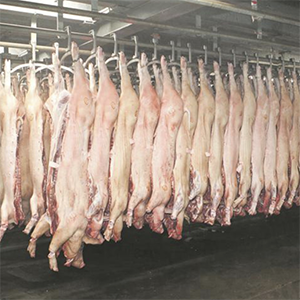Microbial contamination, antimicrobial resistance and biofilm formation of bacteria isolated from a high-throughput pig abattoir

Accepted: 26 January 2022
Supplementary Table: 64
HTML: 14
All claims expressed in this article are solely those of the authors and do not necessarily represent those of their affiliated organizations, or those of the publisher, the editors and the reviewers. Any product that may be evaluated in this article or claim that may be made by its manufacturer is not guaranteed or endorsed by the publisher.
Authors
The aim of this work was to assess the level of microbial contamination and resistance of bacteria isolated from a highthroughput heavy pig slaughterhouse (approx. 4600 pigs/day) towards antimicrobials considered as critical for human, veterinary or both chemotherapies. Samples, pre-operative and operative, were obtained in 4 different surveys. These comprised environmental sampling, i.e. air (ntotal = 192) and surfaces (ntotal = 32), in four different locations. Moreover, a total of 40 carcasses were sampled in two different moments of slaughtering following Reg. (CE) 2073/2005. Overall, 60 different colonies were randomly selected from VRBGA plates belonging to 20 species, 15 genera and 10 families being Enterobacteriaceae, Moraxellaceae and Pseudomonadaceae the most represented ones. Thirty-seven isolates presented resistance to at least one molecule and seventeen were classified as multi-drug resistant. Enterobacteriaceae, particularly E. coli, displayed high MIC values towards trimethoprim, ampicillin, tetracycline and sulphametoxazole with MICmax of 16, 32, 32 and 512 mg/L, respectively. Moreover, isolated Pseudomonas spp. showed high MIC values in critical antibiotics such as ampicillin and azithromycin with MICmax of 32 and 64 mg/L, respectively. Additionally, in vitro biofilm formation assays demonstrated that fifteen of these isolates can be classified as strong biofilm formers. Results demonstrated that a high diversity of bacteria containing antibiotic resistant and multiresistant species is present in the sampled abattoir. Considering these findings, it could be hypothesised that the processing environment could be a potential diffusion determinant of antibiotic resistant bacteria through the food chain and operators.
Supporting Agencies
Ministero della SaluteHow to Cite
PAGEPress has chosen to apply the Creative Commons Attribution NonCommercial 4.0 International License (CC BY-NC 4.0) to all manuscripts to be published.

 https://doi.org/10.4081/ijfs.2022.10160
https://doi.org/10.4081/ijfs.2022.10160



